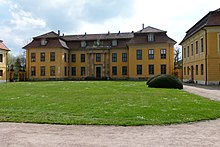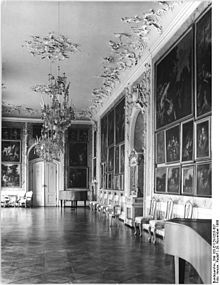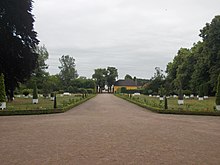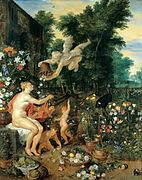Mosigkau Castle
Mosigkau Castle was built as a rococo castle between 1752 and 1757 in the heart of the village of Mosigkau , eight kilometers southwest of Dessau , as a summer residence. It is one of the last remaining Rococo ensembles in Central Germany. His park belongs to the UNESCO World Heritage Garden Kingdom of Dessau-Wörlitz . Special exhibitions and concerts take place regularly in the Mosigkau Castle Museum and in the orangery.
Architecture and history of origin

The unmarried Anhalt Princess Anna Wilhelmine , the favorite daughter of Prince Leopold I of Anhalt-Dessau, was enabled by her father in 1742/43 with a generous donation of two estates and a considerable amount of property to build this splendid palace and garden to let. The donations are noteworthy, as the Principality of Anhalt-Dessau was a real small state and other children of Leopold I von Anhalt-Dessau (a total of ten legitimate children) received similarly extensive allowances. He made his career as a Brandenburg Field Marshal who reformed the army and won battles. In his own state, which he inherited together with high debts, he initiated many reforms in the areas of agriculture, taxes, infrastructure and the settlement of manufactories in his almost fifty-year reign, furthermore he bought up all the manors, so that when he died he would be the largest, if was not the sole landowner of the principality. One portrait shows Anna Wilhelmine, the Prince's daughter with the Dessau pharmacist's daughter Anneliese Föhse, with somewhat coarse facial features but a fine smile; Castle and interior speak for their spirit and their knowledge.
The first drafts and food for thought probably came from the Sanssouci architect Georg Wenzeslaus von Knobelsdorff . The actual builder was the Dessau court builder Christian Friedrich Damm , whom Anna Wilhelmine commissioned to build the summer residence in 1752. Corps de Logis , cavalier houses and farm buildings are located around the courtyard .
Interior and gallery room
Some of the 17 rooms can be viewed in their original state. In the vestibule of the Corps de Logis is a two-armed staircase, here is the tapestry The Triumph of the Church over Idolatry , made in a Brussels workshop based on a design by Peter Paul Rubens around 1630, and originally from the City Palace in Dessau. The middle of the garden side is occupied by the picture gallery, splendidly stuccoed and illuminated by Venetian crystal crowns, with five large glass doors to the outside. It is the cultural and historical highlight, is decorated with rich stucco and houses in recessed wall panels in an original baroque (complete) hanging unique in Germany, important paintings by mainly Flemish and Dutch masters of the 17th century from the " Oranischen inheritance". In order to fit into the wall panels, which are framed by pilasters in green stucco marble, the pictures were partly cut, partly pinned on. A comparable paving was common practice in the 17th and 18th centuries, but has nowhere been preserved in this form. The works include Zephyr and Flora by Peter Paul Rubens, The Princes of Orange by Anton van Dyck and pictures by Jan Brueghel the Elder. Ä. , Jacob Jordaens , Hendrick Goltzius and Gerard van Honthorst .
These pictures originally come from the collection of Amalie zu Solms-Braunfels (1602–1675), wife of the governor of the Netherlands Friedrich Heinrich von Orange and mother of Henriette Catharina von Nassau-Orange , who brought the inheritance to Dessau and her son Leopold I. left behind. Other parts of the collection came to the Royal Palace Dessau , the Oranienbaum Palace and the Gothic House Wörlitz . The palace also contains an extensive collection of portraits of Anhalt princes, including many by Georg Lisiewski and Antoine Pesne . On both sides of the gallery there are two cabinets in Frederician Rococo , with silver tendrils on a blue and yellow background, marble chimneys, embedded pictures and over portraits, Chinese wallpaper and inlaid furniture.
Pleasure garden
The garden borders the gallery hall to the south. In it are hedges with the bowling alley, a fish pond and a maze . The attraction of the rococo garden is the orangery at the rear exit, two flanking buildings with rare and sometimes centuries-old potted plants that line the main path to the castle in the summer months. The statues of Mars, Diana, Flora and a nymph were brought from the park of the Wust manor house to the park of Mosigkau Castle in 1951 .
history
After the mistress of the castle died in 1780, a monastery for noble unmarried women was set up in the castle in accordance with her decree, which existed until 1945. After that, no further changes were made to the building, the furnishings and the living rooms, which were permanently inhabited by the canonesses, so that the ensemble was retained in its original state. The women had refused several times to sell the Mosigkau paintings to the government in Dessau, and so the culturally and historically significant inventory was preserved in its original context.
Walther Pflug worked on the rescue and restoration of the Mosigkau Castle from summer 1945. In 1947 he was appointed curator of the palace by the president of Saxony-Anhalt and was the first director of the Mosigkau palace from 1951 to 1954. From 1951 the palace became a museum for Rococo living .
painting
Wilhelm II of Nassau-Orange as a child ( Anton van Dyck )
The judgment of Paris ( Jan Brueghel the Elder and de Clerck)
Flora and Zephirus (Jan Brueghel the Elder and Peter Paul Rubens )
Ceres and Amphitre (Jan Brueghel the Elder and Hendrik van Balen )
The Contest between Apollo and Pan ( Jacob Jordaens )
Prince Leopold I of Anhalt-Dessau ( Georg Lisiewski )
Others
The main belt asteroid (39405) Mosigkau was named after the castle.
Web links
- Mosigkau Castle
- Garden plan Mosigkau (PDF; 131.12 kB)
- Article and picture gallery from Mosigkau Castle and Park at www.koethener-land.de
- Mosigkau Castle as a 3D model in SketchUp's 3D warehouse
Individual evidence
- ↑ There is a similarly complete hanging in the picture gallery (Sanssouci) , but the works there are not cut and set into wall panels, also reduced by war losses.
Coordinates: 51 ° 48 ′ 21.5 ″ N , 12 ° 9 ′ 3 ″ E










